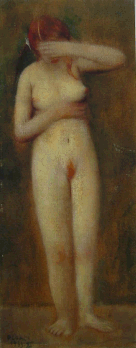Click on image to enlarge and see a cinematic view.
"Snake Tamer's Ditty" copyright 2007 Amy Crehore
(detail of face here, detail of three characters on left side)
 P. Conti, Nudo di giovinetta, 1933
P. Conti, Nudo di giovinetta, 1933 Francesco Trombadori, Fanciulla nuda , 1933
Francesco Trombadori, Fanciulla nuda , 1933 Titian, Venus of Urbino, 1538
Titian, Venus of Urbino, 1538 The Three Graces by Raphael 1504
The Three Graces by Raphael 1504 I always loved this picture of my mom (in the middle) and her sisters.
I always loved this picture of my mom (in the middle) and her sisters. "The Bathers" by Renoir 1887 Philadelphia Art Museum
"The Bathers" by Renoir 1887 Philadelphia Art Museum Study for the Bathers 1884-85 Chicago Art Institute
Study for the Bathers 1884-85 Chicago Art InstituteI found this beautiful study for Pierre-Auguste Renoir's magnificent painting, "The Bathers". This is my favorite Renoir painting. I especially love the character of this girl with the braid down her back. She's rendered so lovingly. This painting has it all. Movement, charm, sex appeal, complexity of composition, rhythm, soul, classicism. And his style is not as brushy in this picture as in his other works.
 1482 Sandro Botticelli, Tempera on wood, Detail from "Primavera"
1482 Sandro Botticelli, Tempera on wood, Detail from "Primavera" Picasso drawing of Marie-Terese Walter
Picasso drawing of Marie-Terese Walter

 Illustrating the book, "Wuthering Heights" (1932-1935), shaped the painting career of Balthus. Many of his paintings were derived from these drawings. As you can see, it's all about angles and geometry with Balthus. That is why I find him so fascinating. For more glimpses of the book : Art Textbooks
Illustrating the book, "Wuthering Heights" (1932-1935), shaped the painting career of Balthus. Many of his paintings were derived from these drawings. As you can see, it's all about angles and geometry with Balthus. That is why I find him so fascinating. For more glimpses of the book : Art Textbooks Here's Marion Peck standing in front of a magnificent painting at the opening of her exhibit at Billy Shire Fine Art over the weekend. It must have taken her a year to paint this painting. Photo courtesy of Val Gal Art . You can read more about her opening by following the link. More power to women painters! I can totally relate to the time spent, the attention to detail and layering of oil paint to get these effects. Good job Marion.
Here's Marion Peck standing in front of a magnificent painting at the opening of her exhibit at Billy Shire Fine Art over the weekend. It must have taken her a year to paint this painting. Photo courtesy of Val Gal Art . You can read more about her opening by following the link. More power to women painters! I can totally relate to the time spent, the attention to detail and layering of oil paint to get these effects. Good job Marion. The new gallery of 19th and 20th-century art at the Pushkin Museum in Moscow includes Gauguin's "Te Arii Vahine" ("The King's Wife"), from 1896. She's posed like an odalisque, but she's the king's wife (not a slave girl). By the way, my new painting will be unveiled early next week. It has taken much longer than expected.
The new gallery of 19th and 20th-century art at the Pushkin Museum in Moscow includes Gauguin's "Te Arii Vahine" ("The King's Wife"), from 1896. She's posed like an odalisque, but she's the king's wife (not a slave girl). By the way, my new painting will be unveiled early next week. It has taken much longer than expected.  Playing 1936
Playing 1936 Standing Nude 1934
Standing Nude 1934 Black Cat 1934
Black Cat 1934 Studio Idyll 1918 by Anders Zorn
Studio Idyll 1918 by Anders Zorn Red Sand 1902 by Anders Zorn
Red Sand 1902 by Anders Zorn Anna May Wong
Anna May Wong Louise Brooks
Louise Brooks Lily Damita
Lily Damita Jean Harlow
Jean Harlow
